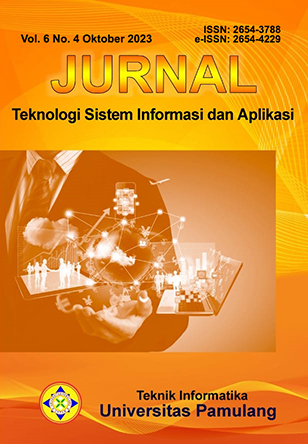Electronic Medical Record Management of Top 10 Outpatient Diseases Using the Waterfall Method
Keywords:
Design, Top 10 Diseases, Electronic Medical Records, ManagementAbstract
This study aims to describe several problems related to data processing of the top 10 outpatient diseases. The research method used is a qualitative research method with a descriptive approach and a waterfall software development method, while the data collection techniques used are observation and interviews with medical record staff. In the research, problems were found such as diagnoses that were difficult to read by poly officers, the existence of duplicate tasks for medical record officers and recording still using manuals filled in by poly officers which were then inputted into the Microsoft Office Excel program and only made worksheets to then be processed back into the top 10 outpatient disease reports. The suggestions given for problem solving are the coordination between officers and doctors regarding the writing of diagnoses, the addition of medical record officers to reduce the workload and the design of a software that can facilitate the process of processing data on the top 10 outpatient diseases using Visual Studio 2012. So that the final report on the top 10 diseases can be accurate and can improve the quality of service in the hospital.References
Adiyanti, R., Teja Sulaksana, P., Syahidin, Y., & Hidayati, M. (2021). Perancangan Sistem Informasi Indeks Penyakit Rawat Inap Menggunakan Microsoft Visual Studio. Jurnal Teknologi Dan Manajemen Informatika, 7(1), 10–19. http://http://jurnal.unmer.ac.id/index.php/jtmi
Afrianti, S., & Musril, H. A. (2020). Perancangan Media Pembelajaran TIK Menggunakan Aplikasi Autoplay Media Studio 8 di SMA Muhammadiyah Padang Panjang. Jurnal Informatika UPGRIS, 6(2), 22–27.
Anggela, W., Syahidin, Y., & Sari, I. (2022). Perancangan Sistem Informasi Index Penyakit Rawat Inap Di RSU Pakuwon Sumedang. Media Bina Ilmiah, 549–554.
Hansen, S. (2020). Investigasi Teknik Wawancara dalam Penelitian Kualitatif Manajemen Konstruksi. Jurnal Teknik Sipil, 27(3), 283. https://doi.org/10.5614/jts.2020.27.3.10
Pedoman Variabel dan Meta Data pada Penyelenggaraan Rekam Medis Elektronik, Pub. L. No. 01.07 (2022).
Peraturan Menteri Kesehatan Republik Indonesia tentang Rekam Medis, Pub. L. No. 24, 1 (2022). https://peraturan.bpk.go.id/Home/Details/245544/permenkes-no-24-tahun-2022
Nurseptaji, A., Arey, A., Andini, F., & Ramdhani, Y. (2021). Implementasi Metode Waterfall pada Perancangan Sistem Informasi Perpustakaan. Jurnal Dialektika Informatika (Detika), 1(2), 49–57. https://doi.org/10.24176/detika.v1i2.6101
Putri, A. L., Yulistio, D., & Utomo, P. (2021). Kemampuan Menulis Teks Laporan Hasil Observasi pada Siswa Kelas X SMK Negeri 3 Seluma. Jurnal Ilmiah Korpus, 5(1), 45–51. https://doi.org/10.33369/jik.v5i1.13449
Putri, T. N., Syahidin, Y., & Wahab, S. (2022). Perancangan sistem informasi peminjaman dan pengembalian rekam medis menggunakan microsoft visual studio dan framework CI berbasis web. Jurnal Pendidikan Tambusai, 6(2). https://garuda.kemdikbud.go.id/documents/detail/2843075
Rahmawati, I., Abdussalaam, F., & Sari, I. (2023). Tata Kelola Rekam Medis Berbasis Elektronik Dalam Pengelolaan Pelaporan Instalasi Rawat Jalan Dengan Metode Waterfall. Decode: Jurnal Pendidikan Teknologi Informasi , 3(2), 310–321. https://doi.org/10.51454/decode.v3i2.201
Ramadhan, D. R. P., Rosyada, A. Q., Marliza, W., Kasatri, D. E. P., & Yuliana, I. (2020). Pengaruh Ekstrakulikuler Coding pada Siswa Sekolah Dasar Guna Meningkatkan Computational Thinking di Sekolah Al-Azhar Syifa Budi Solo. Buletin Literasi Budaya Sekolah, 2(1), 80–86. https://doi.org/10.23917/blbs.v2i1.11616
Sri Mulyani, E., Wanda Agustin, I., Herfiyanti, L., & Mecca, C. (2022). Perancangan Sistem Informasi Kelengkapan Berkas Klaim BPJS IGD Menggunakan Metode Waterfall Di Rumah Sakit Muhammadiyah Bandung. Jurnal Teknik Informatika Dan Sistem Informasi, 9(3), 1784–1798. http://jurnal.mdp.ac.id
Wahid, A. A. (2020). Analisis Metode Waterfall Untuk Pengembangan Sistem Informasi. Jurnal Ilmu-Ilmu Informatika Dan Manajemen STMIK, 1–5.
Downloads
Published
How to Cite
Issue
Section
License
Copyright (c) 2023 Rizki Salma Oktaviana, Selly Puji Anisha, Yuda Syahidin, Irda Sari

This work is licensed under a Creative Commons Attribution-NonCommercial 4.0 International License.
Authors who publish with this journal agree to the following terms:
- Authors retain copyright and grant the journal right of first publication with the work simultaneously licensed under a Creative Commons Attribution License that allows others to share the work with an acknowledgement of the work's authorship and initial publication in this journal.
- Authors are able to enter into separate, additional contractual arrangements for the non-exclusive distribution of the journal's published version of the work (e.g., post it to an institutional repository or publish it in a book), with an acknowledgement of its initial publication in this journal.
- Authors are permitted and encouraged to post their work online (e.g., in institutional repositories or on their website) prior to and during the submission process, as it can lead to productive exchanges, as well as earlier and greater citation of published work (See The Effect of Open Access).
Jurnal Teknologi Sistem Informasi dan Aplikasi have CC BY-NC or an equivalent license as the optimal license for the publication, distribution, use, and reuse of scholarly work.
In developing strategy and setting priorities, Jurnal Teknologi Sistem Informasi dan Aplikasi recognize that free access is better than priced access, libre access is better than free access, and libre under CC BY-NC or the equivalent is better than libre under more restrictive open licenses. We should achieve what we can when we can. We should not delay achieving free in order to achieve libre, and we should not stop with free when we can achieve libre.
This work is licensed under a Creative Commons Attribution-NonCommercial 4.0 International (CC BY-NC 4.0) License
YOU ARE FREE TO:
- Share - copy and redistribute the material in any medium or format
- Adapt - remix, transform, and build upon the material for any purpose, even commercially.
- The licensor cannot revoke these freedoms as long as you follow the license terms



_2020_-_7(2)_2024_-_Thumbnail.png)












